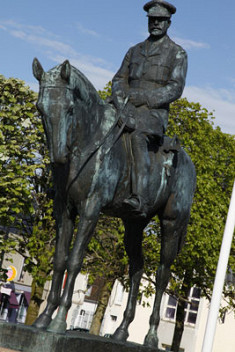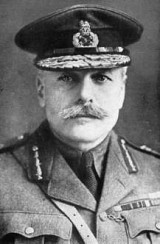Contents
Move to Montreuil
Initially set up in Saint-Omer in October 1914, the General Headquarters (GHQ) of the British Army was subsequently transferred to Montreuil in March 1916. Carefully planned by the British military authority, the move was a natural response to the changing face of the conflict and the increased front that the British troops were expected to defend from 1916 onwards. The town of Montreuil was chosen for a number of reasons, most notably for its infrastructure and immediate surroundings. Its geographical position was ideal because the various British bases on French soil (ports, garrisons, training camps, depots...) were all within easy reach, it was situated at a reasonable distance from the front, and it was also halfway between the Allied capitals of London and Paris. Montreuil also had the capacity to house the various departments of GHQ thanks to the numerous buildings of the military academy. Not only did the arrival of GHQ in Montreuil in 1916 increase what was already a massive military presence in the region, it also propelled the hitherto peaceful fortified town on to the world stage as the military capital of the First World War.
Nerve centre of the British Army
Although the principal role of the GHQ in Montreuil was to develop and decide the strategies to be used on the battlefield, it nevertheless had other responsibilities such as ensuring and coordinating the presence of the British troops in France. To quote one of its officers, "GHQ was responsible for transporting supplies and equipment imported from England, it managed all the transport networks and decided the construction of new roads..."
Divided into five departments, the GHQ of Montreuil was an enormous administrative body staffed with a wide range of military personnel, from private soldiers to field officers, with at its head Field Marshal Sir Douglas Haig, commander-in-chief of the British Army.
The British commander-in-chief
Successor to Field Marshal Sir John French, Haig remained commander-in-chief until the end of the war. When at Montreuil GHQ, Haig would reside with his immediate entourage at Beaurepaire, a country house a few kilometres from the town. His life there was organized down to the last detail to accommodate the incessant round of meetings and conferences with military staff and prestigious visitors as well as regular trips to London, Paris and the front. A particularly discreet leader, Haig was rarely seen in the town except on Sundays when he would attend the religious service at the Scottish Churches Hut. An enthusiastic horseman, the British "C-in-C" enjoyed riding through the countryside around Montreuil in the company of his personal escort. Haig's personality and his actions during the war have been and still are the subject of much debate among historians, with admirers paying tribute to his quality as a great strategist and detractors pointing to his "inhuman" use of power. Whatever the truth of the matter, the figure of Field Marshal Haig continues to be, as the historian J.M. Winter put it, "one of the most controversial in British military history".
Civilians and soldiers at GHQ
Rationing
The arrival of GHQ made rationing even more acute for the civilian population and access to bars was strictly regulated for civilians and soldiers alike. People could move around the town during most of the day (5 a.m. till 10 p.m.) but no one could enter or leave the town between 8 p.m. and 5 a.m. Street lighting was removed and civilians were obliged to black out the windows of their houses every night. The supply of food and coal became more of a problem from 1916 onwards when the people of Montreuil, like all their compatriots, had to endure an explosion in the prices they paid for basic foodstuffs such as meat, butter, sugar and bread. With these products in such short supply the civil authorities attempted to attenuate the excesses of the profiteers with the creation in 1917 of a town provisioning committee which was mandated to acquire stocks of goods which could then be sold on to the civilian population at almost cost price.
The Tommies of Montreuil
British military personnel attached to GHQ were accommodated in and around the town. General officers took up residence in the neighbouring large country houses while the subalterns and the non-commissioned officers were put up in lodgings or lodged with troops in nearby barracks. Most of the British soldiers who worked at GHQ had fond memories of Montreuil as a picturesque town surrounded by beautiful countryside. Private H. Spring remembers, "Compared to Rouen, Montreuil was a far more beautiful and colourful place". "Montreuil was a pleasant place and the men were even happier there than at Blendecques (near Saint-Omer)", noted an officer of the Honourable Artillery Company.
When not standing guard or working at something, the soldiers were given some free time to play sports, such as tennis, football, roller-skating or swimming, or other activities such as fishing, painting, drawing, and acting (both cinema and theatre). A recreation room set up at the initiative of the GHQ's chaplain was put at the disposal of the troops for socializing during the week and for religious services every Sunday. As for the officers, they spent their free time in a clubhouse set up on the premises of the nursery school on rue du Paon. The officers' mess was a cosmopolitan place which enjoyed an excellent reputation throughout the Allied armies, in particular for the quality of its wine cellar.
Franco-British relations
Relations between the British military and the local civilian population, like those between the town council and the GHQ top brass, were on the whole cordial. Through various charitable events and acts of generosity the British Army managed to conquer the hearts and minds of the people of Montreuil and those who sought refuge there. The existence of romantic liaisons between young French women and the Tommies, as well as simple friendships established over the many months of the war, indicated that relations between the military and the locals were good; however this does not mean that there were no points of contention between them. On the contrary, in addition to the restrictions imposed on civilian movements, numerous disputes related to requisitioning and compensation arose to cloud relations. The trade in alcohol and, in particular, prostitution were also sources of tension during the war.
End of the war and return to anonymity
The sombre spring of 1918
The German offensive of March 1918 provoked another mass exodus of the civilian population and by April many refugees were arriving in Montreuil and creating a situation similar to that of 1914. In May 1918 nearly 20,500 refugees were living in the district. The arrival of huge numbers of distressed civilians soon overloaded the hospitals in the area, with severe outbreaks of flu, measles and dysentery compounding the situation. Morale among the civilian population was at its lowest and alarmist rumours from the front began to spread panic. "Scaremongers say that Arras is taken, that Saint-Pol is in ruins, that the Germans have broken through our lines," wrote the sub-prefect on 30 March 1918.
The trauma only escalated when Montreuil suffered its first air raid on the following 31 May with the bombs of the German air force claiming their first victim and causing some damage. General Headquarters was once again targeted on 21 August 1918 at about 8.30 p.m., the bombers claiming two more victims: an English corporal by the name of Benson and a French lieutenant called De Hees.
The joys of victory
The Allied counter-offensive of the summer of 1918 brought about a profound change in the opinion of the people of Montreuil. Gone were the pessimism and panic that shadowed the spring, the sub-prefect going as far as to warn of "an excess of optimism". "Never have spirits been higher," he wrote on 24 July 1918, a few months before the counter-offensive finally brought the Allies victory. On 11 November 1918 Montreuil was the scene of immense jubilation with civilians and soldiers united in an unprecedented wave of enthusiasm. Several days later on 27 November King Georges V, accompanied by Field Marshal Haig, made a triumphant passage through Montreuil on his way to Paris but, however intense they may have been, the joys of victory were not enough to eradicate the memory of four years of fighting, privations, worry and suffering endured by civilians and soldiers alike. The people of Montreuil would also mourn the loss of 126 soldiers from their town who fell on the battlefields of the Great War.
The departure of the British
The British GHQ in Montreuil was dissolved in early 1919. The British Army spent a busy few weeks moving paperwork and archives relating to its activities and dismantling, with the help of German prisoners of war, telephone and telegraph lines and prefabricated buildings which had been set up during its time in the town. The British Military Authority and Montreuil Council organized a leaving ceremony in early April 1919 during which Field Marshal Haig personally thanked his French hosts before returning, for the last time, on the 5 April 1919, to Great Britain. Freed from the censorship which restricted reporting during the war the local press were quick to reflect on the feeling of relief among the public that accompanied the lifting of restrictions, in particular the curfews. With its characteristic frankness, the newspaper Le Journal de Montreuil also paid tribute to the British who "spent a lot of money in the region; the shopkeepers and farmers owe them their fortunes".
Yann HODICQ
Member of the History and Archeology Commission
of the Pas-de-Calais département





